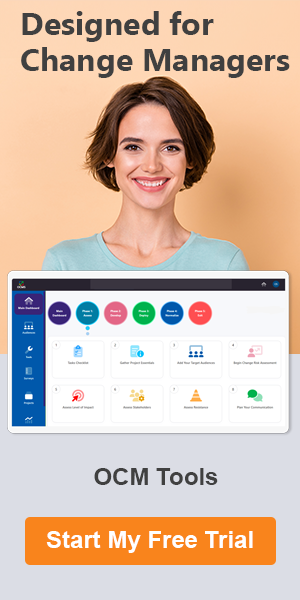Your Guide to Powerful Employee Awareness Communications
– Free Examples, Samples, & Step-by-Step Checklist
In this practical guide, we’re going to show you the best AI awareness communication examples, Ai awareness plan and approach and samples you can use immediately to boost employee understanding of AI changes, reduce resistance, and guide your organization through AI adoption with clarity and confidence.
To help you seamlessly implement these strategies, we’ve also prepared a free AI Communication Plan checklist, provided sample AI Awareness communication drafts and other free resources in the sections below. These free resources and examples will guide you through each step of building and rolling out your AI awareness communication plan.
Let’s dive into it.
Ogbe Airiodion | Change Management Consultant, OCM Lead, Change Coach | Strategic & Tactical Change Management Implementation
Let’s get started
Watch this overview video or read the detailed guide below.
Table of Contents – AI Awareness Communications Guide
- Use Case: How Alex Leveraged Best AI Awareness Comms to Increase Success
- Laying the Groundwork: The AI Awareness Communication Plan
- Crafting Your Message: Approaches and Samples for AI Awareness
- Making it Actionable: How to Deploy Your AI Awareness Plan
- Free Downloadable Checklist: Your AI Awareness Playbook
- Conclusion: Empowering Your Workforce for the AI Era
- Frequently Asked Questions (FAQ)
Pro Tip: Keep this guide open while preparing your next AI-related announcement. It’s your messaging blueprint.
Use Case: How Alex Leveraged Best AI Awareness Comms to Increase Success
For our use case today, let us discuss Alex, a team lead whose company was about to introduce new AI tools. The initial buzz among his team was a mix of curiosity and apprehension. Some worried about their jobs, others felt overwhelmed by the thought of learning complex new technologies. Without clear, proactive communication, this uncertainty could have spiraled into resistance.
But Alex’s project and change team understood the critical need for a strong AI awareness communication plan. They didn’t wait for questions; they proactively explained what AI was, how it would benefit everyone, and what it wouldn’t do.
Through clear messaging and engaging discussions, they transformed initial anxieties into excitement, turning employees into curious learners ready to embrace the future. This article will empower you to create that same positive shift within your organization, laying a strong foundation for successful AI integration.
This article gives you the same advantage: a ready-made communication strategy that works, plus step-by-step instructions for how to use it at your organization.
Pro Tip: Don’t reinvent the wheel, reuse a strategy that’s already worked. Then tailor it to your organization’s voice.
What Makes This the Best Awareness Communication Plan
This awareness communication plan works because it tackles the real issue behind AI resistance: silence. Most failed rollouts happen not because AI tools don’t work, but because employees never received clear, reassuring communication upfront.
This plan delivers:
- Phased awareness messaging
- Language that’s clear, human, and supportive
- Internal templates you can copy and send
- A timing structure based on what real companies use
It’s built around what employees are actually thinking, not just what leadership wants to say. That’s what makes it effective.
Pro Tip: Don’t flood people with feature lists. Focus on the one thing they want to know: “How will this help me?”
Laying the Groundwork: The AI Awareness Communication Plan
Before any new AI tool is even considered for rollout, establishing a robust AI awareness communication plan is important. This isn’t just about sending out an email; it’s about systematically educating impacted users, addressing their concerns, and building a foundation of understanding and trust.
A best awareness plan directly impacts future employee awareness for AI adoption and ensures a smoother transition.
Your AI awareness communication plan should begin by defining the core purpose: to demystify AI, manage expectations, and highlight the potential benefits for employees.
This involves moving beyond technical jargon and focusing on human-centric explanations. Consider grouping your communication efforts around key themes.
For instance,
- Start with fundamental concepts of AI – what it is, common examples (like smart assistants or recommendation engines), and how it’s already present in their daily lives.
- Then, transition to how AI will specifically impact your organization, focusing on how it will assist employees, automate mundane tasks, and free them up for more strategic and creative work. This proactive approach helps to alleviate common fears and sets a positive tone.
A good AI awareness communication plan will clearly outline your objectives, target audiences (e.g., all employees, specific departments), key messages, chosen communication channels, and a realistic timeline.
Prioritize clear and consistent messaging to ensure everyone receives the same foundational information. This initial awareness phase is crucial for building buy-in and laying the groundwork for subsequent AI adoption efforts.
Free AI Communication Plan – Excel Download
Pro Tip: Think of your awareness plan as an ongoing conversation, not a one-time announcement. Regular, bitesize communications are more effective than a single, lengthy document.
Crafting Your Message: Approaches and Samples for AI Awareness
Now that you understand the importance of planning, let’s dive into the best approaches and samples for your AI awareness communication plan.
The goal here is to make AI relatable, understandable, and exciting, not intimidating. This section will provide you with practical ideas and sample AI awareness communications you can adapt.
Focus on “What’s In It For Me?” (WIIFM)
Employees want to know how AI will affect them. Instead of focusing solely on technological features, highlight the direct benefits. Will it reduce tedious tasks? Enhance decision-making? Create opportunities for new skills? Your effective AI messaging to employees should emphasize these personal gains.
Sample AI Awareness Communication (Company-Wide Announcement)
Subject: Get Ready to Work Smarter, Not Harder: Introducing AI at [Company Name]!
Hi Team,
We’re thrilled to share an exciting step forward in our commitment to innovation and empowering you, our incredible employees.
Soon, we’ll begin integrating Artificial Intelligence (AI) tools into our operations. We know AI can sound complex, but think of it as a powerful co-pilot designed to help you streamline your work, automate repetitive tasks, and free up your time for more creative and strategic thinking.
This isn’t about replacing roles; it’s about enhancing your capabilities and making your work more impactful and engaging. In the coming weeks, we’ll be sharing more details about how these intelligent tools will make a positive difference in your day-to-day.
Get ready to embrace a new era of productivity and innovation!
<Signature>
Demystify with Simple Language and Examples
Avoid technical jargon. Use analogies and real-world examples that resonate with your employees’ daily experiences.
Sample AI Awareness Communication (Intranet Post / Newsletter Snippet)
AI Explained: It’s Like a Smart Assistant for Your Everyday Tasks!
“Heard the buzz about AI? At its core, AI helps computers learn and make smart decisions, much like how your smartphone learns your preferences or your GPS finds the fastest route. In our workplace, AI will act as a smart assistant.
Imagine it quickly sifting through data to find insights, drafting routine reports, or helping you organize information more efficiently. It’s designed to take on the repetitive stuff, so you can focus on the truly important work that requires your unique skills and creativity.
Over the next month, we’ll introduce you to some of these practical applications that will make your work life easier.”
<Signature>
Proactive Q&A and Myth-Busting
Address common concerns and misconceptions head-on. This builds trust and shows you’re listening.
Sample AI Awareness Communication (Internal Memo / FAQ Snippet):
Subject: Your Questions About AI: Addressing Common Concerns
As we embark on our AI journey, we understand you might have questions.
That’s great! We encourage them. One common question is, ‘Will AI take my job?’ Our answer is clear: Our AI strategy is focused on augmentation, not replacement.
We believe AI will enhance our human capabilities, automating tasks that are repetitive or time-consuming, allowing you to dedicate more energy to strategic thinking, problem-solving, and direct interaction with clients or colleagues.
We are committed to providing training and support to help you adapt and thrive with these new tools. Look out for upcoming workshops and dedicated Q&A sessions.
<Signature>
Additional Awareness Messaging:
📢 Teams/Slack Message
“We’re rolling out AI tools to make your work easier, not harder. Stay tuned for upcoming tips, training, and success stories from your colleagues.”
🧠 AI Awareness FAQ (Included as attachment or SharePoint link)
“Want to know what AI can and can’t do? Download our FAQ to learn how AI works with
🎙️ Leader Talking Points
“As leaders, our job is to make AI real for our teams, not scary. Focus on how it will reduce busywork and give teams back valuable time.”
📊 Include on a Slide for Awareness Roadshow
“AI at Work: Simplifying Tasks, Supporting People, Strengthening Outcomes. We’re launching tools to help you, not replace you.”
Leverage Different Channels for Your AI Communications and Messaging
Vary your communication methods to reach everyone effectively. An email template for AI awareness can be a great starting point for formal announcements, but complement it with other channels.
- Key Channels for Awareness:
- Company-wide Emails: For broad announcements and key updates.
- Intranet/Internal Portal: A central hub for resources, FAQs, and deeper dives.
- Town Halls/All-Hands Meetings: For leadership to share vision, answer questions live, and build enthusiasm.
- Team Meetings: For managers to facilitate smaller, more personal discussions.
- Internal Newsletters: Regular snippets and stories about AI’s potential.
Pro Tip: Don’t just tell, show. Use simple visuals, short videos, or even brief demonstrations of AI’s capabilities to make your message more tangible and impactful.
Making it Actionable: How to Deploy Your AI Awareness Plan
Having a great AI awareness communication plan on paper is one thing; effectively deploying it is another.
This section provides actionable steps and guidance on how you can use your plan and sample AI awareness communications to create meaningful engagement and readiness within your workforce.
- Phase Your Communications: Don’t overwhelm employees with too much information at once. Break down your awareness campaign into manageable phases.
- Phase 1: Initial Announcement & Vision Setting: This is where you introduce the concept of AI, its broad benefits, and your organization’s vision. Use a clear and compelling sample internal announcement for AI rollout.
- Phase 2: Demystification & Benefits: Focus on explaining AI in simple terms, providing relatable examples, and highlighting the “what’s in it for me” for various roles. Leverage your email template for AI awareness.
- Phase 3: Myth-Busting & Q&A: Proactively address common concerns (job security, complexity) through dedicated FAQs and open forums.
- Phase 4: Glimpse into the Future: Share inspiring case studies or pilot project successes (even small ones) to show tangible benefits.
- Train Your Messengers: Your managers, change champions, and team leads are crucial. Equip them with talking points, FAQs, and a clear understanding of the AI strategy so they can confidently answer questions and address concerns within their teams. Provide them with resources like “manager’s guides to AI awareness.”
- Create a Central Hub: Establish a dedicated section on your company intranet or internal portal for all AI-related information. This should include:
- Your overall AI awareness communication plan.
- FAQs (regularly updated).
- Links to external resources for learning more about AI basics.
- Videos or infographics explaining AI concepts.
- A feedback mechanism (e.g., an email address or anonymous suggestion box) for employees to submit questions or AI concerns.
- Listen and Adapt: Awareness isn’t a one-way street. Actively solicit feedback from employees through surveys, town halls, and informal discussions. Be prepared to adjust your messaging and approach based on their questions, concerns, and level of understanding. This iterative process is key to building trust, reduce resistance to AI, and ensuring your AI readiness communication plan truly resonates.
- Celebrate Early Wins (Even Small Ones): As you begin to see small successes in AI adoption or even just increased employee curiosity, highlight them. Share stories of how employees are starting to understand or engage with AI concepts. This reinforces the positive impact and encourages others.
Pro Tip: Consider creating a small “AI Ambassador” program where early enthusiasts or more tech-savvy employees can help spread awareness and answer peer questions in an informal setting.
Free Downloadable Resources: AI OCM Checklist, AI Awareness Playbook and More
To ensure you don’t miss a beat in creating a robust AI awareness communication plan, we’ve developed a free, downloadable checklist. This practical tool breaks down the entire process into actionable steps, from defining your audience to crafting compelling messages and selecting the right channels.
It’s designed to be your go-to resource for making sure your employees are informed, engaged, and ready for the exciting possibilities AI brings.
We are also providing additional free resources
[Free Downloadable Checklists & Free Templates]
Pro Tip: Print out this checklist and use it as a working document with your communication and leadership teams to ensure all aspects of your AI awareness strategy are covered.
Conclusion: Empowering Your Workforce for the AI Era
Building employee awareness for AI adoption is the critical first step toward unlocking the transformative power of Artificial Intelligence within your organization.
By investing in a well-thought-out AI awareness communication plan, utilizing clear and relatable sample AI awareness communications, and following actionable deployment steps, you are not just introducing new technology; you are empowering your workforce. You are helping them understand, adapt, and ultimately thrive in an AI-powered future. Remember, successful AI integration begins not with algorithms, but with people – informed, confident, and prepared people.
Pro Tip: Your commitment to AI awareness should be evident from the top down. Visible leadership engagement in communication efforts significantly boosts employee confidence and buy-in.
Frequently Asked Questions (FAQ) – OCM for AI Implementation
What is an AI awareness communication plan?
An AI awareness communication plan is a structured approach to inform and prepare employees about upcoming AI tools, focusing on clarity, benefits, and addressing concerns to support adoption.
How do I write a sample AI awareness email?
Start with a clear subject, explain what the AI tool is, why it’s being introduced, and how it will help. End with next steps and where employees can go for support.
What’s the best way to communicate an AI rollout to staff?
Use a multi-channel approach including email, town halls, internal sites, and direct manager briefings. Repetition and reinforcement are key.
Why is change management important for AI implementation?
AI tools often change how people work. Without managing the human side of that change, adoption drops and value is lost.
What is an AI awareness communication plan and why is it important?
An AI awareness communication plan is a structured strategy designed to educate employees about Artificial Intelligence, its basic concepts, and how it will impact their roles and the organization. It's crucial because it helps to demystify AI, address fears, build trust, and create a foundational understanding that prepares employees for successful AI adoption. Without it, confusion and resistance can hinder even the most advanced AI implementations.
How can I make sample AI awareness communications relatable to all employees?
To make sample AI awareness communications relatable, focus on simple language and avoid technical jargon. Use analogies that compare AI to everyday experiences, like a smart assistant or a helpful tool that streamlines tasks. Most importantly, highlight the direct benefits for employees, such as reduced workload, improved efficiency, or opportunities for skill development, rather than just the technology itself.
What are the key elements of an AI readiness communication plan?
A key AI readiness communication plan should include defined communication objectives (what you want employees to know, feel, and do), identified target audiences, clear and consistent key messages, a selection of appropriate communication channels (e.g., email, intranet, town halls), a timeline for staggered information release, and mechanisms for feedback and addressing concerns. It should proactively prepare employees for the changes ahead.
What's the best approach to addressing employee concerns about AI taking their jobs?
The best approach is to be transparent and emphasize augmentation over replacement. Clearly communicate that your organization's AI strategy aims to enhance human capabilities, automate mundane tasks, and free up employees for more strategic and creative work. Highlight opportunities for reskilling and upskilling, and demonstrate a commitment to supporting employees through the transition, perhaps with AI onboarding communication plan elements.
How often should we communicate AI awareness to employees?
AI awareness communication should be an ongoing process, not a one-time event. While there will be initial intensive phases, regular, bite-sized updates are highly effective. This could include weekly intranet posts, monthly newsletter snippets, or quarterly town hall discussions. Consistent reinforcement helps to embed understanding and maintain a positive sentiment towards AI, preventing information overload and keeping the topic relevant.
Pro Tip: Remember, the goal of AI awareness is to inform and inspire, not to dictate. Foster an open environment where employees feel comfortable asking questions and sharing their perspectives.
Note: Content on OCM Solution's ocmsolution.com website is protected by copyright. Should you have any questions or comments regarding this OCM Solutions page, please reach out to Ogbe Airiodion (Change Management Lead) or the OCM Solutions Team today.






